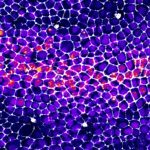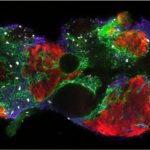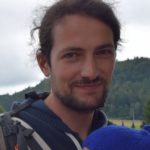About
Despite our deep knowledge of the pathways regulating cell proliferation, growth and survival, we still do not understand how single cells can match their behavior to properties of the entire tissue (including its size and shape). Mechanical forces can convey tissue scale information (tissue size, density) to single cells. While the effects of mechanical forces on cell proliferation have been widely studied, their influence on cell survival have been poorly studied in vivo. Recently, it was shown that a local increase of cell density in an epithelium can induce cell extrusion and elimination. We recently showed that caspase activation is necessary for cell elimination in the pupal notum (a single layer epithelium). We are currently trying to identify new regulators of apoptosis induction which are sensitive to cell deformation and tissue crowding.
Cell delamination in the pupal notum (purple)
We are also testing how spatial constrains could affect cell survival in various developmental contexts and test their contribution to morphogenesis and tissue size regulation. We use a combination of live imaging (particule image velocimetry, tissue segmentation and cell tracking) and clonal analysis to understand how this could help to fine tune the proportion of dying cells in growing tissues, during programmed tissue clearance and during tissue homeostasis.
Finally, we are trying to understand how crowding induced death can contribute to the competitive interactions between different cell types. Cell competition is a process inducing the elimination of slow proliferating cells by faster proliferative cells through apoptosis. Cell competition is a conserved mechanism required for the correction of developmental errors, to fine tune tissue size and could contribute to tumor expansion through the elimination and replacement of neighbouring healthy cells by pretumoral cells. We and others have recently shown that fast growing clones resistant for apoptosis can promote WT cell eliminations though their compaction and induction of apoptosis. We use a combination of genetics, live imaging, laser nanodissection and theory to understand how spatial constrains can contribute to cell competition and how confrontation of two cell populations can lead to cell compaction and elimination.
Compaction and elimination of WT cells by a fast growing clone (purple, through Ras hyperactivation)









